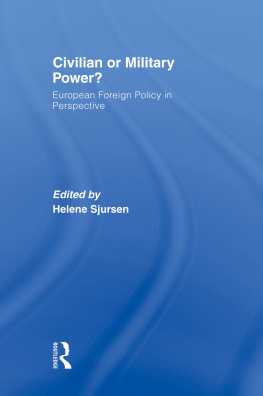First published 2012
by Routledge
711 Third Avenue, New York, NY 10017
Simultaneously published in the UK
by Routledge
2 Park Square, Milton Park, Abingdon, Oxon OX14 4RN
Routledge is an imprint of the Taylor & Francis Group,an informa business
2012 Taylor & Francis
The right of Niels Bjerre-Poulsen, Helene Balslev Clausen, and Jan Gustafsson to be identified as the authors of the editorial material, and of the authors for their individual chapters, has been asserted in accordance with sections 77 and 78 of the Copyright, Designs and Patents Act 1988.
All rights reserved. No part of this book may be reprinted or reproduced or utilised in any form or by any electronic, mechanical, or other means, now known or hereafter invented, including photocopying and recording, or in any information storage or retrieval system, without permission in writing from the publishers.
Trademark notice: Product or corporate names may be trademarks or registered trademarks, and are used only for identification and explanation without intent to infringe.
Library of Congress Cataloging in Publication Data
Projections of power in the Americas / edited by Niels Bjerre-Poulsen,
Helene Balslev Clausen, and Jan Gustafsson.
p. cm. (Routledge studies in the history of the Americas ; 2)
Includes bibliographical references and index.
1. Power (Social sciences)AmericaHistory. I. Bjerre-Poulsen,
Niels. II. Clausen, Helene Balslev. III. Gustafsson, Jan, 1955
JC330.P755 2012
303.3097dc23
2011039609
ISBN: 978-0-415-51747-8 (hbk)
ISBN: 978-0-203-12360-7 (ebk)
Introduction
Power and its Multiple Projections in the Americas
Two phenomena are of central interest in the nine contributions that make up this volume: one is the question of power and its projections in multiple forms, the other is that geographical, political, and cultural multifaceted unity we call the the Americas. The contributors to this volume come from a variety of academic fields and accordingly take different theoretical, disciplinary, and empirical approaches to the study of power. This is, in other words, a multidisciplinary effort, written by scholars from the fields of history, political science, anthropology, sociology, and cultural studies, who share an interest in the ways in which power is projected in the Americas.
In some of the essays, the focus is on a specific dimension of power and its projection. In others, the question of power is an implicit, although essential factor for the understanding of an empirical problem. Some contributors focus on the sources of power, while others are more concerned with how it is presented and legitimized by those who hold it. Likewise, some investigate the relations between government and citizens, whereas others look at more informal structures of power. Common to all contributions, however, is that they attempt to trace the forms that political and social power might take in different social contexts in the Americas.
WHY THE AMERICAS?
A fundamental objective of this volume is to connect the question of power and its projections to a specific region of the worldthe Americas. Whereas few people would question the relevance of a volume on power in the U.S., North America, or Latin America, the chosen hemispheric perspective might seem less obvious. Most books related to area studies or specific regions would still tend to focus on specific countries or on either Latin America or the U.S.
That the destinies of North, Central, and South America are closely entangled is of course not a recent discovery, and the relevance of this perspective is difficult to deny.perspective, especially in the U.S. and in Mexico. A growing literature within different academic disciplines, such as history and social sciences, is another testimony of an interest in a wider perspective on the Americas.
Some years ago, British historian Felipe Fernndez-Armesto received appraisal for his hemispheric approach to the history of the Americas. Fernndez-Armestos book clearly demonstrated many of the advantages of placing events in the individual American countries and regions in this larger context. We believe that this hemispheric perspective is far from sufficiently explored, and that our effort here to combine such a perspective with a multidisciplinary approach can further contribute to a wider understanding of the Western Hemisphere, with its similarities and differences, parallels, and contradictions.
Power constitutes a privileged and multifaceted field of study that permeates most other social phenomena. In all social relations, power tends to be present in some respect, being sometimes overt and obvious, sometimes hardly perceivable.
A brief look at the current state of inter-American relations could lead to the conclusion that the hemispheric perspective has lost its relevance in recent years. Is that indeed the case? While the U.S. was a dominant presence in hemispheric politics throughout most of the 20th century, the North American superpower and Latin Americaor at least South Americanow appear to be following different paths.
One obvious example is the project of creating one big common free trade zone in the hemisphere. It was de facto abandoned in 2004, after harsh criticism from several South American presidents. The tensions that were apparent in the debate were about more than trade politics: a number of Latin American leadersrightly or wronglysaw the entire project as a last attempt to sustain U.S. dominance in their region. It was seemingly the very notion of a unipolar Western Hemisphere that had become unacceptable.
The creation of UNASUR (the Union of South American Nations) in 2008, and of The Organization of Latin American and Caribbean States in 2010 seems to confirm this trend. So do the approaches to international relations that some Latin American states have takenmost noticeably Brazil, the hemispheres second largest country. Nevertheless, we contend that the hemispheric perspective is as relevant now as it was a decade ago.
One argument can be found by turning the attention from regional and international relations to the fields of migration, culture, and communication. Here, the Americas is not merely a concept, but the day-to-day reality of millions of people. More than 40 million people of Latin American descent now live and work in the U.S., and a much larger number maintain contact with these people and receive monetary and other types of remittances from them. Spanish spoken media based in the U.S., Mexico, or other American countries transmit to the whole hemisphere, and thus contribute to the creation of new supranational or transnational cultures.












